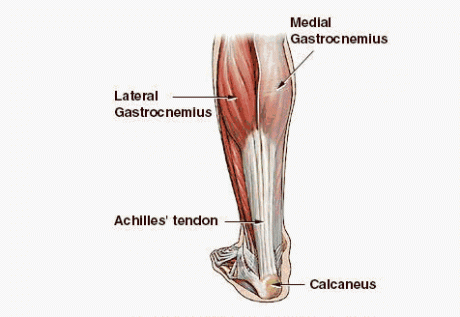Achilles Tendon Rupture June 29, 2010
Posted by Joanna Wilson in Uncategorized.Tags: achilles, achilles tendon, achilles tendon rupture, football, football injuries, football injury, Phsyiotherapy, physiocare, physiotherapy, physiotherapy reading, RICE, RICE Treatment, Sporting injury, Sports injury, sports injury reading
trackback
 The Achilles tendon is the largest and strongest tendon in the body. It is also the most common tendon to rupture, with about 1 in 5,000 affected at any one time. The Achilles tendon connects the calcaneus (heel bone) to the middle of the calf muscle. As the calf muscle contracts, it tightens the Achilles tendon pulling the heel upwards, a movement that is used in basic walking, running and jumping.
The Achilles tendon is the largest and strongest tendon in the body. It is also the most common tendon to rupture, with about 1 in 5,000 affected at any one time. The Achilles tendon connects the calcaneus (heel bone) to the middle of the calf muscle. As the calf muscle contracts, it tightens the Achilles tendon pulling the heel upwards, a movement that is used in basic walking, running and jumping.
Injuries to the Achilles tendon are common in sports which can over stretch the tendon i.e. football and basketball. A complete tear of the tendon is known as an Achilles tendon rupture. Ruptures can be common in people, who do recreational sports or have a weak Achilles tendon due to long-term corticosteroid use, tendonitis or rheumatoid arthritis. In sports it is more likely to be caused by a forceful push off with the athlete’s foot causing the strong contraction in the calf muscle, overextending the Achilles tendon. Prevention can be helped by having a good warm up and cool down regime.
Symptoms are sudden and severe pain in the Achilles area. The athlete may hear a loud pop or snap sound and a gap may appear 2 inches above the heel. They may be unable to weight bear or have a flat footed walk. They will be unable to stand on tip toes. Pain, swelling and stiffness will be followed by bruising and weakness.
Initially, R.I.C.E. treatment should be used but if a rupture is suspected don’t walk on affected foot and seek immediate medical help. Prompt treatment equals better recovery. Diagnosis of a ruptured Achilles tendon will be confirmed at the hospital. The doctor may perform the Thompsons Test (calf squeeze test). You will be asked to lie on your stomach on the bed with knees bent. The doctor will then squeeze your calf muscle and watch your ankle for movement. If the tendon is ok the foot will briefly point away from leg (plantar flexion). If no movement, a rupture is confirmed.
There is then two options open to you, surgical or conservative treatment. Surgical treatment is usually used by professional sports people because the recovery time is quicker and there is decrease risk of re-rupture.
Recent research has altered how Achilles tendon ruptures are treated. Plaster casting used to be used for 6-8 weeks, changed every 2 weeks and then weight bearing and physiotherapy would begin. Now it is thought movement is better for recovery both for surgical and non surgical intervention. Walking casts or adjustable braces are now used after non weight bearing for 2 weeks, then range of movement exercises are begun, decreasing the recovery time.
Your physiotherapist will give you an exercise regime and may try various techniques to reduce the pain. These may include exercises and soft tissue techniques (deep tissue massage). They will also advise you on returning to exercise and how to strengthen your muscles.
Comments»
No comments yet — be the first.